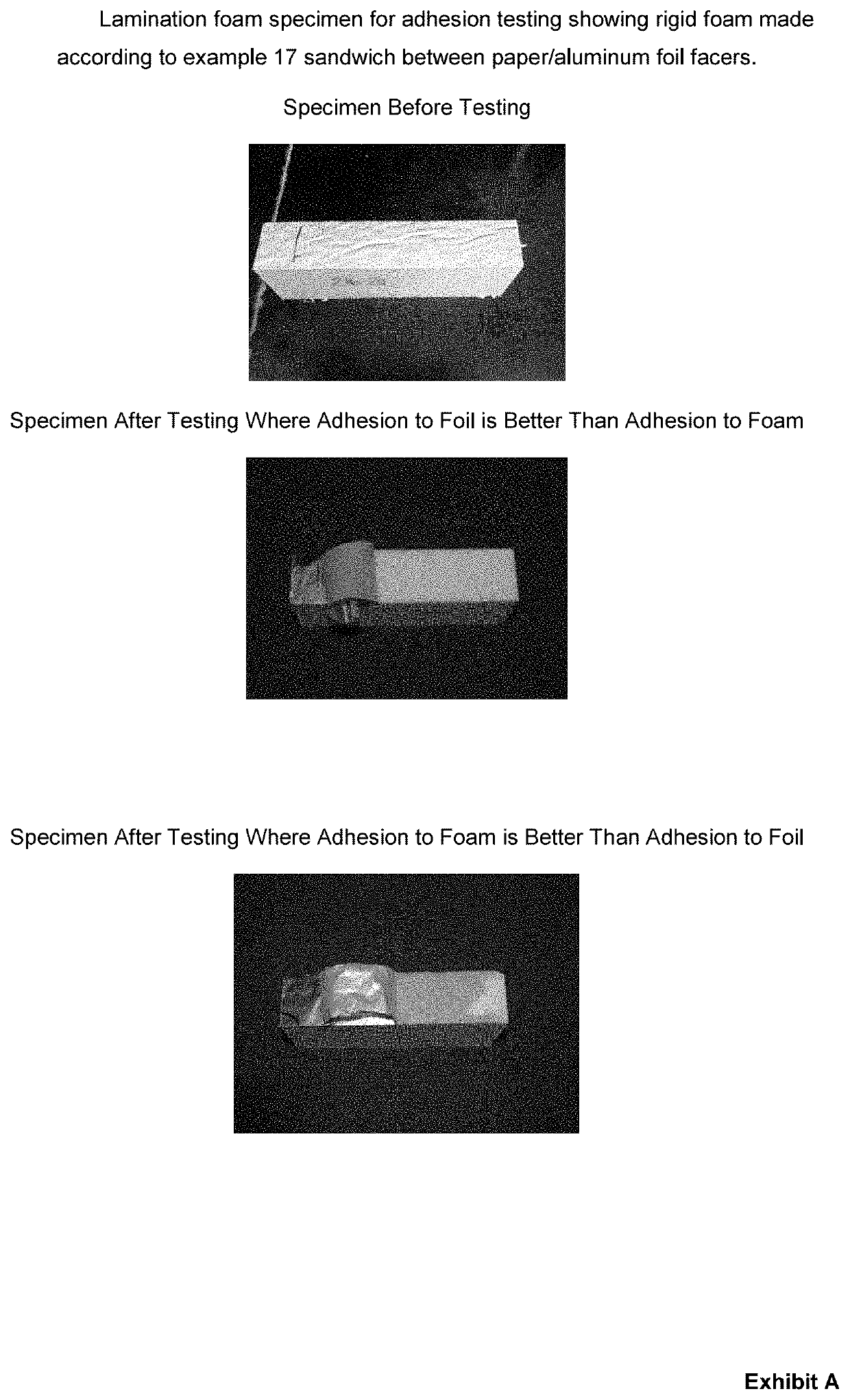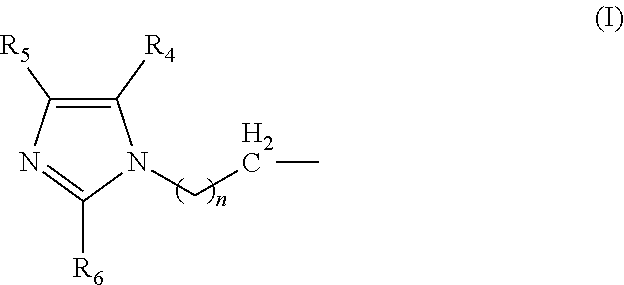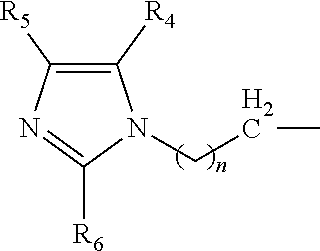Amine composition useful for making polyurethane foam
a technology of polyurethane foam and composition, applied in the field of amine composition useful for making polyurethane foam, can solve the problems of reducing storage stability, affecting the ozone layer or contributing to global warming, and limited the use of hfos, so as to improve the storage stability of isocyanate reactive mixture, reduce emissions, and reduce amine odor
- Summary
- Abstract
- Description
- Claims
- Application Information
AI Technical Summary
Benefits of technology
Problems solved by technology
Method used
Image
Examples
example 1
[0143]This example describes the synthesis of N-2-cyanoethyl-imidazole (CE-IM) as an intermediate to prepare some catalysts of this invention.
[0144]Imidazole (300 g) and water (60 g) were charged into a stainless steel reactor equipped with mechanical stirrer, heating mantle, cooling coil and a high pressure syringe pump connected with stainless steel feeding lines. Then the steel reactor was sealed and purged with N2 for three times. The temperature of the reactor was increased to 50° C. and stirred for 30 min to help dissolve all the imidazole. Acrylonitrile (304.6 mL) was then charged into the reactor from a high pressure syringe pump at a speed of 150 mL / hour while maintaining the reactor temperature at 50° C. Once addition was completed the reactor was held at 50° C. for ˜10 hours before the heating was shut down. The reactor was then vented after cooling to room temperature. All volatiles were removed on a rotary evaporator under vacuum. CE-IM was collected in 98.5% yield and ...
example 2
[0146]This example describes the synthesis of N-(3-aminopropyl)-imidazole (AP-IM) as an intermediate to prepare some catalysts of this invention.
[0147]Isopropyl alcohol (IPA, 400 mL) and Raney cobalt (16 g) were charged into a stainless steel reactor equipped with mechanical stirrer, heating mantle, cooling coil and a high pressure syringe pump connected with stainless steel feeding lines. Then the steel reactor was sealed and purged with N2 for three times followed by H2 for three times while stirring. CE-IM (806 g) was charged into the high pressure syringe pump. The reactor was heated to 100° C. and the H2 gas pressure was adjusted to 800 psi. CE-IM was dispensed from the pump into the reaction over ˜4 h period. After all CE-IM was dispensed, the reaction was held at 100° C. for 1 hour before the heating was shut down. The reactor was then vented after cooling to room temperature. All volatiles were removed on rotary evaporator under reduced pressure. The catalyst was removed via...
example 3
[0150]This example describes the synthesis of Product 1A (defined below) as a catalyst of this invention.
[0151]IPA (200 mL) and 5% Pd / C (containing 50% water, 25.6 g) were charged into a stainless steel reactor equipped with mechanical stirrer, heating mantle, cooling coil and a high pressure syringe pump connected with stainless steel feeding lines. The steel reactor was sealed and purged with N2 three times followed by H2 three times while stirring. CE-IM (416.6 g) was charged into the high pressure syringe pump. Dimethylamine (DMA, 450.1 g) was then transferred into the reactor. The reactor was heated to 80° C. and the H2 gas pressure was adjusted to 800 psi. All CE-IM was dispensed from a high pressure syringe pump into the reactor for over ˜4 h. Once CE-IM was dispensed, ˜30 mL IPA was charged into the pump and dispensed into the reactor over 1 min, and this process was repeated for two more times to make sure all leftover CE-IM was washed into the reactor. The reactor was then...
PUM
| Property | Measurement | Unit |
|---|---|---|
| temperatures | aaaaa | aaaaa |
| temperature | aaaaa | aaaaa |
| density | aaaaa | aaaaa |
Abstract
Description
Claims
Application Information
 Login to View More
Login to View More - R&D
- Intellectual Property
- Life Sciences
- Materials
- Tech Scout
- Unparalleled Data Quality
- Higher Quality Content
- 60% Fewer Hallucinations
Browse by: Latest US Patents, China's latest patents, Technical Efficacy Thesaurus, Application Domain, Technology Topic, Popular Technical Reports.
© 2025 PatSnap. All rights reserved.Legal|Privacy policy|Modern Slavery Act Transparency Statement|Sitemap|About US| Contact US: help@patsnap.com



